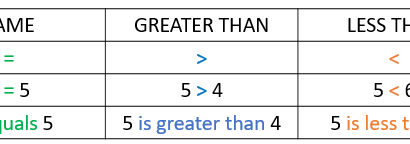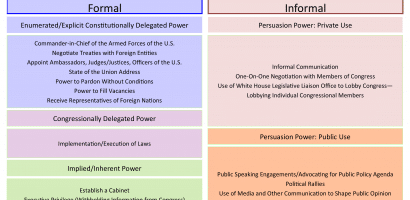From a very young age, most of us have heard the name Dante. So, even if we did not come across him in literature, we must have come across Dante’s inferno levels in general knowledge. Therefore, the word “Inferno” is something we all know now, thanks to Dan Brown’s bestseller. However, that is not all about it. There is a long literary and religious history. Hence, Inferno is in reality the Italian for what we call Hell. Moreover, the book that rings a bell in our mind every time we hear Dante’s name is Divine Comedy. So, in this book, the first part is called Inferno. Moreover, after this comes Purgatorio or purgatory, and Paradiso or Paradise.

Dante Alighieri was a 14th-century Italian poet, the most famous of his time and ever since. So, his epic poem Divine Comedy is a matter of discussion even today. Therefore, Inferno enumerates the journey that Dante undertook through Hell. Moreover, in the process, he took the guidance of the ancient Roman poet Virgil. Hence, in his epic poem, he describes Hell in nine concentric circles of torment. All of them are located inside Earth. So, these are Dante’s inferno levels. He says that it is the realm of those who have rejected all their moral and spiritual values. Therefore, they have resorted to violence and have become beastly. Moreover, they have made a perverse use of their human intellect to trap their fellow human beings in fraudulence or malice.Read Also:Inherent Powers of President: All you need to know
Additionally, many consider Divine comedy as its allegory. So, one represents the journey that the soul undertakes to reach God. On the other hand, the other describes the process of recognizing and rejecting sin.

Dante’s inferno levels meaning
So, as we can already understand, Dante categorizes the architecture of his hell or Inferno into what we are calling Dante’s inferno levels. Hence, he constructs this in the form of circles. Moreover, there are nine such circles or levels in total that he talks about. Now, on another note, we also know that Christianity lists several sins that are condemned. There are seven of them that we call the 7 deadly sins. So, these are pride, greed, wrath, envy, lust, gluttony, and sloth. Therefore, interestingly, we find a number of them to be various of Dante’s inferno levels or circles, though not all. Each of these circles talks about a characteristic that is considerably hellish. So, we will see more of that in the ensuing sections. However, let us first take a look at an overview of Dante’s Inferno for a better understanding.
/illustration-to-the-divine-comedy-by-dante-alighieri--abyss-of-hell---1480-1490--found-in-the-collection-of-the-biblioteca-apostolica-vaticana--486777773-5c3a03c246e0fb00016261f2.jpg)
Dante’s inferno levels explained
Dante follows Virgil’s instructions in drawing the nine circles of hell that form Dante’s inferno levels. Moreover, these circles are concentric. Therefore, this means that as one moves towards the center of the earth, the wickedness increases. So, inner the circle, the more wicked it is. And finally, at the center of the Earth, Satan is held captive. So, sinners from every circle receive a punishment en route to eternity. However, the punishment differs considering each of their crimes. Every one of the punishments is a contrapasso. Therefore, this is a symbolic understanding of poetic justice.

Structurally, Dante’s inferno levels take inspiration from Aristotle. However, he incorporates some Christian symbolisms, exceptions, and misconstructions of what Aristotle had written. Moreover, he also took inspiration from De Officiis by Cicero. So, coming to Cicero, he had divided sins into two types. Therefore, these are Violence and Fraud. Now, Dante combined Cicero’s violence and Aristotle’s bestiality. Moreover, he also combines the former’s fraud with the latter’s malice. Therefore, he formulated three major categories of sin. Moreover, he symbolized these with three beats that we find in his first canto. So, these are incontinence, violence or bestiality, and finally fraud or malice.

As per the Ethics that Aristotle wrote, bestiality or malice is much more condemnable than incontinence. So, these sinners find a place in the four circles of Upper Hell or Dante’s inferno levels which are from the second to the fifth circle. Moreover, they get far less torment than those who stay in the circles of the lower hell. The circles of lower hell are located within the walls of Satan’s residence or the City of Dis. Here the sinners who committed violence or fraud go. Moreover, Dante added more subdivisions and his hell has finally 24 divisions.

Dante’s inferno nine levels of hell
So, from the previous section, we have already seen the primary structure of Dante’s inferno levels. However, because he was a Christian, Danto added one circle to Upper Hell and one- the 6th circle to Lower Hell. Therefore, this makes 9 circles total. Moreover, he also includes the Vestibule of the Futile. So, this sums up to 10 main divisions of Dante’s Hell. However, this 9 + 1 division is not a characteristic of Dante’s inferno levels alone. His Purgatorio and Paradiso also bear the same structure. Moreover, he has also further subdivided the lower hell. The 7th circle has in it 3 rings. In addition to this, circle 8 also has ten bolge and circle 9 has in it 4 different regions. So, this is how Hell has a total of 24 divisions.

So, we will know more about each of Dante’s inferno levels individually in detail. However, let us first take a quick look at the names of all of them for easier understanding.

Dante’s inferno levels of hell names
So, we will begin from the first circle pointwise. Therefore, the names of Dante’s inferno levels are-
- The first circle or Limbo
- The second circle or Lust
- The third circle or Gluttony
- The fourth circle or Greed
- The fifth circle or Anger
- The sixth circle or Heresy
- The seventh circle or Violence
- The eighth circle or Fraud
- The ninth circle or Treachery
Therefore, these are the major ones of Dante’s inferno levels. As we know, several of these have more subdivisions.
Dante’s inferno levels 9 circles
So, now that we have already seen what the 9 of Dante’s inferno levels are, let us see each of them individually in detail.
Dante’s inferno Limbo level
The first of Dane’s inferno levels or circles of Hell is Limbo. So, this one is not exactly for the sinners but the infidels. Hence, non-Christians and pagans that do not undergo baptism reside here. They are punished with eternity in a space that is much inferior to the Christian Heaven. Therefore, they stay here inside a castle that has seven gates. Each of these gates symbolizes a particular virtue. Moreover, Dante believes this is where great figures from classical antiquity reside. So, such figures include Homer, Socrates, Aristotle, Cicero, Hippocrates, and Julius Caesar.
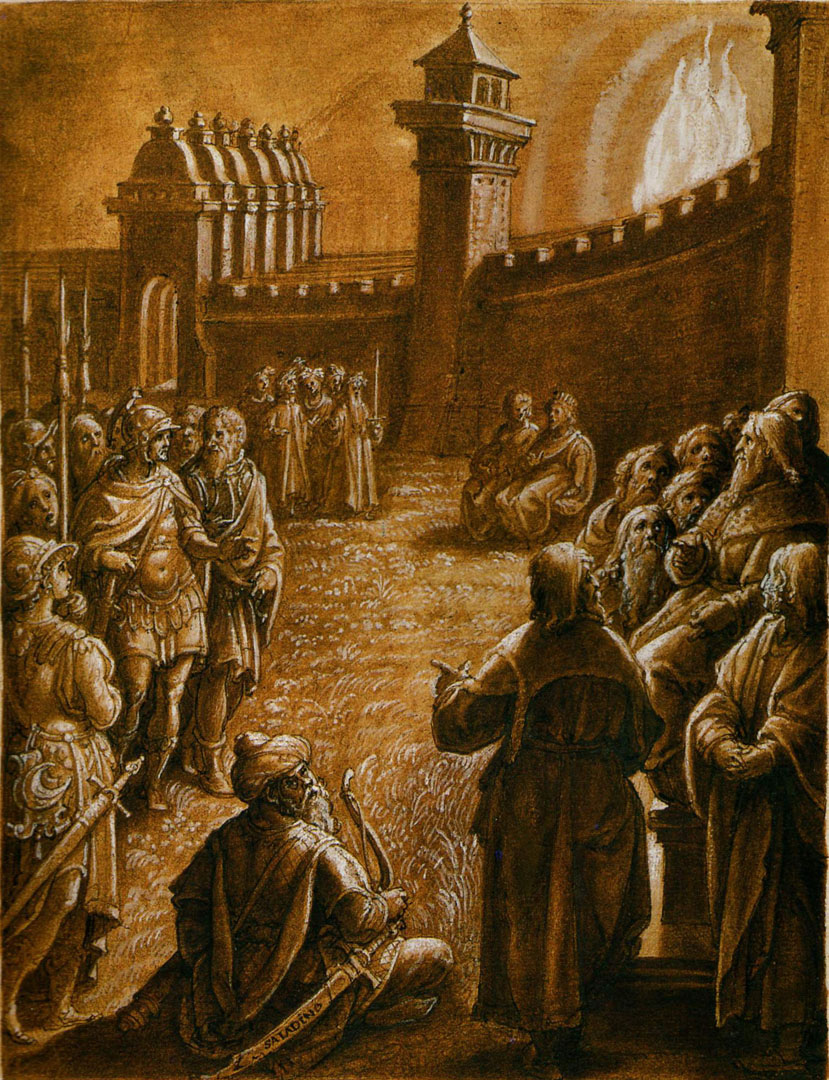
Dante’s inferno Lust level
So, this is the second amongst Dante’s inferno levels or circles of Hell. Here Dante, under the guidance of Vigil places people who gave in to lust. So, the punishment that they receive is violent back and forth movement via strong winds that prevent them from finding any peace or stability. However, the winds are symbolic. They show the restlessness of someone whose fleshly pleasures motivate constantly. Here Dante places sexually lecherous people from history and mythology. These include people like Helen of Troy, Tristan, Cleopatra, and others who have had a lifetime of adultery.
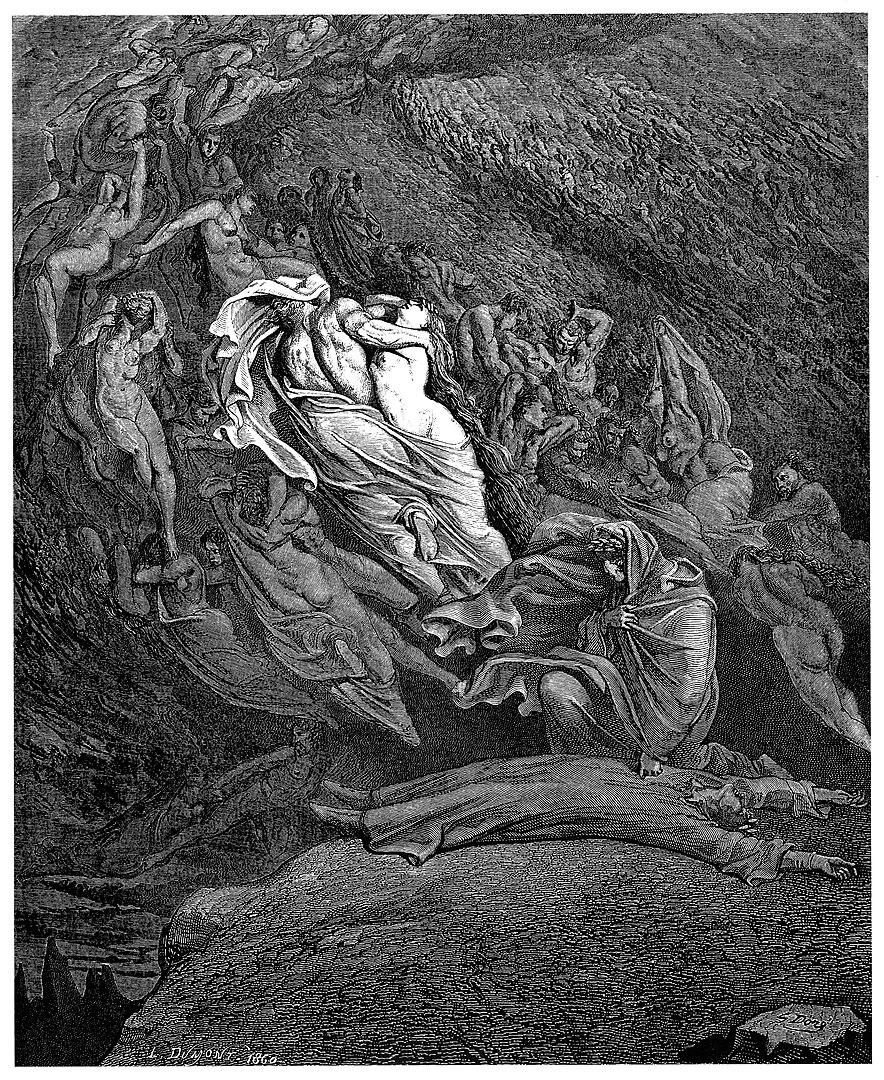
Dante’s inferno Gluttony level
In the third of Dante’s inferno levels, he and Vigil place the souls of gluttons. Moreover, Cerberus, a worm monster, constantly overlooks them. So, like in the other circles, here also sinners receive a special and painful punishment. So, here they have to lie in a vile slush. Moreover, a never-ending icy rain led to its formation. This vile slush is symbolic of personal degradation that comes when one indulges in food, drink, and other mundane desires more than one should. Meanwhile, they ignore those who need them because they are selfish and cold. In this circle, we find Dante speaking to a character called Ciacco. Moreover, this character tells him that the Guelphs (a faction supporting the Pope) will defeat and expel the Ghibellines (a faction supporting the Emperor to which Dante adhered) from Florence. However, this occurred in 1302, around 6 years before the poem was written.
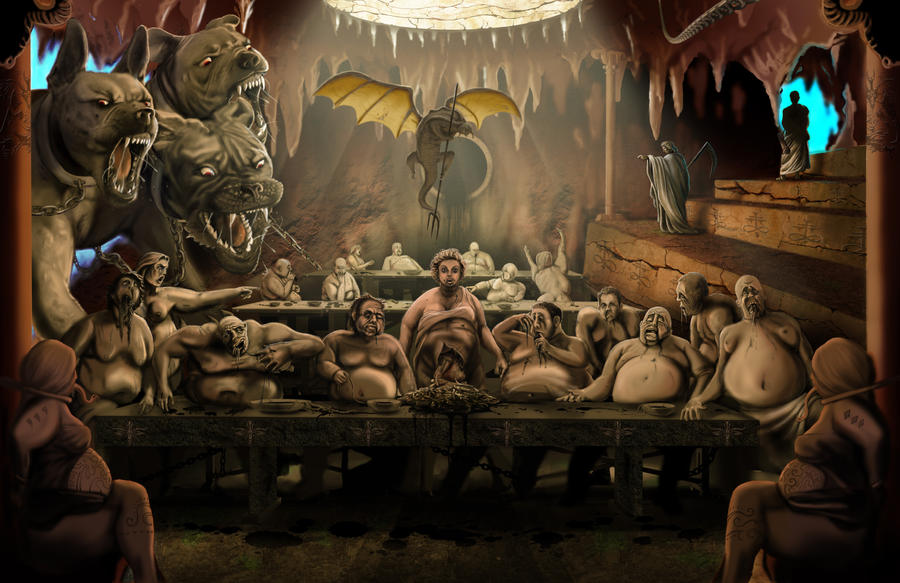
Dante’s inferno Greed level
So, the fourth one in Dante’s inferno levels is Greed. Therefore, both Dante and Virgil here find people who receive punishment for their greed. Moreover, these sinners have two categories- those who hoarded belongings limitlessly and those who spent more than they could- jousting. Hence, they face a difficult punishment whereby they have to tolerate heavyweights being pushed over their chests. So, this symbolizes their self-centered push to acquire wealth throughout their life. Moreover, Pluto- the ancient Greek ruler of the underworld guards these two groups. However, both the groups are very much into their actions. So, the poets do not try interacting with them. It is interesting to see Dante telling this could be the lookout for many clergymen, even cardinals and popes.

Dante’s inferno Anger level
So, the next of Dante’s inferno levels is anger. Therefore, the wrathful and sullen find their punishments here for their sins. So, they come here by riding on a boat that Phlegyas drives. Moreover, Dante and Virgil can see while coming here mad fights on the surface of the river Styx. This results in a sullen gurgling under the surface of the water. So, the punishment is relevant to the crimes that the sinners have committed in their lifetime. Here, the poets find a prominent Florentine politician Filippo Argenti. So, in his lifetime he had confiscated Dante’s property and expelled him from Florence.
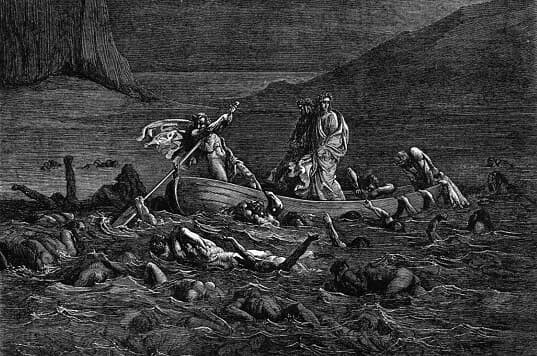
Dante’s inferno Heresy level
In the sixth circle of Dante’s inferno levels, both Virgil and he come across heretics who are sentenced to eternity in tombs that are set on flames. So here, Dante talks with some people from Florence. Hence, these include Farinata degli Uberti and Cavalcante de’ Cavalcanti. However, he also comes across some famous figures from history. So, these include the Greek philosopher Epicurus, The Holy Roman Emperor Frederick II, and Pope Anastasius II. However, many recent critics argue that the pope was a mistake on the part of Dante. On the other hand, he probably meant Anastasius I, the Byzantine Emperor.
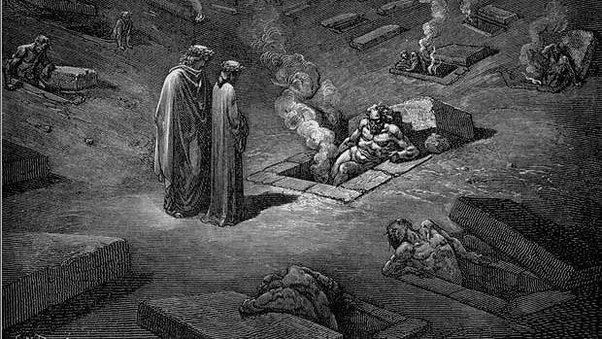
Dante’s inferno Violence level
So, this one is a little different from the rest of Dante’s inferno levels that we have seen till now. Therefore, there are 3 rings in this seventh circle. In the outer ring, Dante places the murdered and people who forced violence on innocent people and their property. So, in a bold stroke, Dante mentions this is to be the residence of Alexander the Great, Dionysius I of Syracuse, Guy de Montfort, and the likes of such. Moreover, he also includes mythological figures like Centaurus who drowned in a river whose water was boiling with blood and fire. Moreover, in the middle ring, he sees suicides. They have become trees and bushes and harpies feed on them. However, he also finds profligates here. Dogs chase them and tear them into pieces.
Finally, in the inner ring, he finds the sodomites and the blasphemers. They stay in a desert with burning sand. Moreover, burning rain falling continuously washes them from the sky.
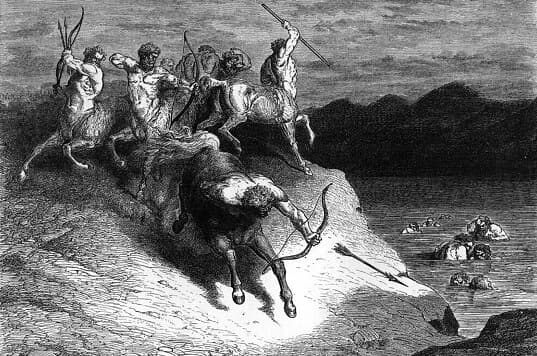
Dante’s inferno Fraud level
So, the eighth of Dante’s inferno levels is the residence of the fraudulent. A flying monster, Geryon takes Dante and Virgil here on its back. Moreover, this monster has different natures, hence symbolizing fraudulence. However, the interesting part is that there are 10 Bolgias or stony ditches in this circle. Moreover, bridges connect all the Bolgias with them.
In the first Bolgia, Dante finds seducers and panderers. So, in the next one, there are flatterers. Then there is a bridge to the third Bolgia. Here those guilty of simony stay. Therefore, another bridge takes them to the fourth Bolgia where some sorcerers and prophets are false. Moreover, Bolgia 5 houses corrupt politicians. There are hypocrites in the 7th Bolgia, evil counselors and advisors in the 8th one, and divisive people in the 9th. Finally, in the last Bolgia, they found alchemists, counterfeits, perjurers, and other falsifiers.

Dante’s inferno Treachery level
So, in the last one of Dante’s inferno levels, there are 4 rounds. Moreover, the rounds depend directly on how serious the sin is. However, all the residents of this level stay in an icy lake and are frozen. The more severe the sin, the deeper they are in ice. Every round takes its name from someone who symbolizes that sin. Therefore, the first one is Caina, which comes from Cain who killed his brother Abel. Moreover, round 2 is Antenora which comes from Antenor of Troy. So, he was the one who counseled Priam during the Trojan War. Up next, the third round is Ptolomaea after Ptolemy who was the son of Abubus. Hence, the final round is Judecca after Judas Iscariot- one of the 12 apostles who betrayed Jesus simply with a kiss.

Dante’s inferno levels and punishment
So, we have already seen the punishments that the sinners receive in Dante’s inferno levels in detail, individually. We are not repeating that here. However, the thing that should be striking is how Dante masterfully shows every punishment is not just linked with the sin that the sinner had committed. It also reverses the sin and makes the sinner realize what effect his sin had on someone else and humankind at large for that matter.
Dante’s inferno levels of purgatory
So by now, we have already understood that Purgatorio and Inferno are two separate spaces that Dante talks about. Therefore, Dante’s inferno levels do not exactly work here. However, just like Dante’s inferno levels, he has levels in Purgatorio or purgatory as well. Moreover, we have already seen the 7 Christian sins. Some of the inferno levels take their name from them. However, the place where Dante represents all the 7 deadly sins is Purgatory. Therefore, there are 7 levels and they are named after all the 7 sins. Therefore, these are-
- Pride
- Envy
- Wrath
- Sloth
- Avarice or Greed
- Gluttony
- Lust
He called these the 7 terraces.

Dante’s inferno levels of Heaven
Just as in Purgatorio, Dante’s inferno levels cannot exactly work in his Heaven or Purgatorio. However, there are levels as well. Moreover, just like in his Hell or Inferno, Dante places nine levels in Heaven or Paradiso to show how they are reciprocal to each other. Therefore, he names them after the nine spheres of Heaven and believes in their traditional symbolism. Therefore, these are-
- the Moon
- Mercury
- Venus
- the Sun
- Mars
- Jupiter
- Saturn
- the Fixed Stars
- the Primum Mobile
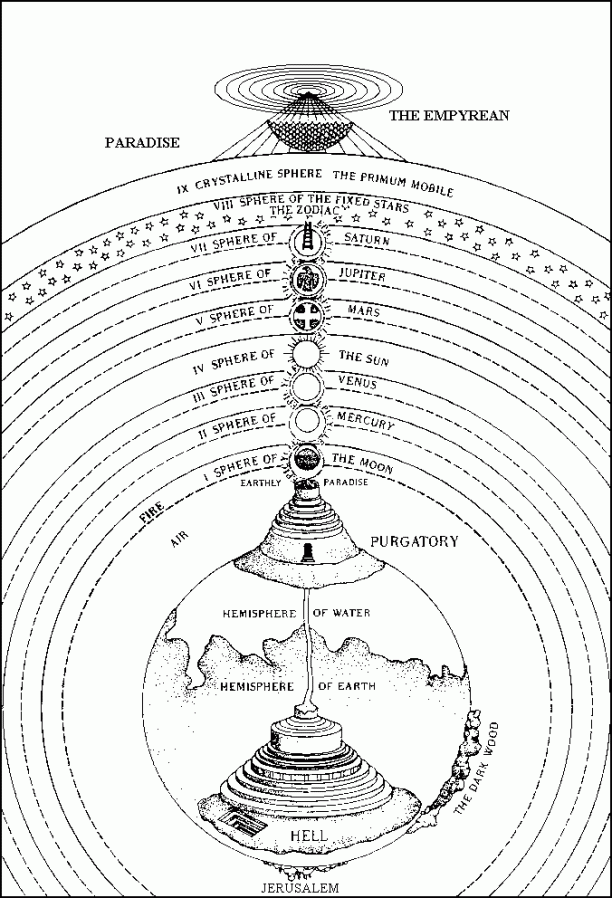
Dante’s inferno levels FAQs
Why is number 3 important in Dante’s Inferno?
Ans. Well so, this is because of several reasons. The number 3 refers to sin. Moreover, there are 3 kinds of sins- incontinence, violence, and fraud.
How many circles are there in Dante’s inferno?
Ans. So, there are 9 circles in Dante’s inferno in total. To know about them in detail, scroll up and go through the “Dante’s inferno levels 9 circles” section.
How many Bolgias are there?
Ans. So, you find Bogias or Bolge in the eighth of Dante’s inferno levels, which is fraud. There are 10 Bolge. Moreover, to know about them in detail, go through the “Dante’s inferno Fraud level” section.
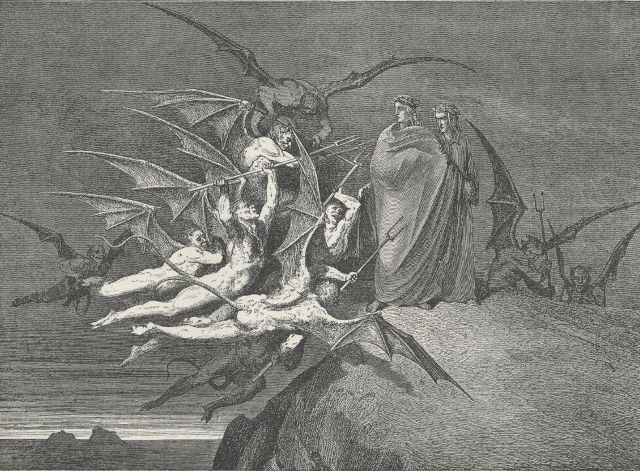
Where do liars go in Dante’s Inferno?
Ans. Liars and betrayers like Judas go into the lake of ice that is in the last of Dante’s inferno levels, which is Treachery.

What does the term Malebolge mean?
Ans. So, the word Malebolge is Italian meaning “evil ditches”. Therefore, it is a large cavern that is in the shape of a cavern. Moreover, it is itself further divided into ten concentric circular trenches or ditches. Hence, each of these trenches is called a bolgia. So, the word bolgia is the Italian for a pouch or a ditch. Moreover, you can find them in the ninth of Dante’s inferno levels.

